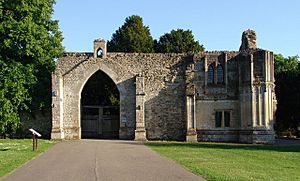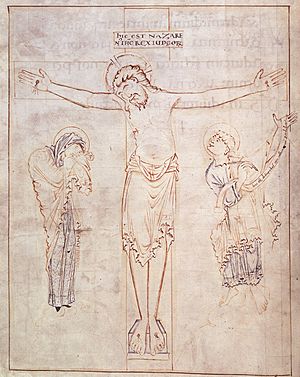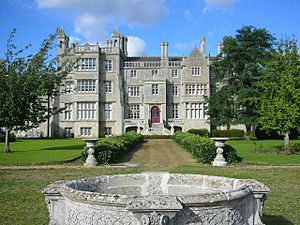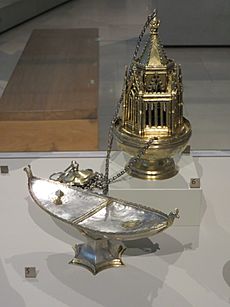Ramsey Abbey facts for kids
Quick facts for kids Ramsey Abbey |
|
|---|---|

Remains of Ramsey Abbey Gatehouse
|
|
| Location | Ramsey, Cambridgeshire, England |
| Area | Huntingdonshire |
| Founded | 969 |
| Built | 10th–16th centuries |
| Demolished | 1537 |
| Official name: Ramsey Abbey (remains of) | |
| Reference no. | 1006838 |
| Lua error in Module:Location_map at line 420: attempt to index field 'wikibase' (a nil value). | |
Ramsey Abbey was a large Benedictine monastery in Ramsey, England. It was founded around the year 969 AD. The abbey was closed down on November 22, 1539, during a time called the Dissolution of the monasteries.
Today, the area where the abbey stood is a Scheduled Ancient Monument. This means it is a nationally important historical site. Most of the abbey's buildings were taken down after it closed. However, some parts still stand and are protected as important historic buildings. The Ramsey Abbey Gatehouse is looked after by the National Trust. The Church of St Thomas à Becket, Ramsey was also once part of the abbey.
Contents
Building Ramsey Abbey: A New Beginning
Ramsey Abbey was started in 969 by Oswald, who was a bishop. He built it on land given by Æthelwine, Ealdorman of East Anglia (also known as Earl Ailwyn). Æthelwine had already built a small wooden chapel there for three monks.
The English Benedictine Reform
The abbey's founding was part of a big movement in the mid-10th century. This movement was called the English Benedictine reform. It aimed to improve and restart monasteries across England. Other famous places like Ely and Peterborough were also reformed at this time. Æthelwine gave the new abbey many properties, including land at Bodsey and Houghton Mill.
Early Scholars and Important Books
A smart scholar from France, Abbo of Fleury, visited Ramsey Abbey between 985 and 987. Oswald invited him to teach there. While at Ramsey, Abbo wrote two books for his students. These books were called Passio S. Eadmundi and questiones grammaticales.

An important old book called the Ramsey Psalter (or Psalter of Oswald) comes from this time. It is an Anglo-Saxon illuminated psalter, made in the late 900s. An "illuminated manuscript" is a handwritten book with beautiful drawings and decorations. People think this book was made for Ramsey Abbey or for Oswald himself. There is another book also called the Ramsey Psalter, but it was made much later, between 1286 and 1316.
Building the First Stone Church
Æthelwine first built a small home for three hermits (people who live alone for religious reasons). This was on Ramsey island, which was surrounded by fenland. Oswald was impressed and sent a leader, Germanus, and twelve monks to start the abbey.
Starting in 969, a large church made of stone was built. It took five years to finish. The church had two towers. The smaller tower was at the front, facing west. It looked beautiful from far away. The larger tower was in the middle of the church, supported by four columns and arches. This first stone abbey building stood until the 12th century. Then, a new abbot (the head of the abbey) had an even grander church built.
Challenges and Importance
In 1143, a powerful person named Geoffrey de Mandeville took over the abbey. He used it as a fort and caused a lot of damage. For three centuries, the abbey also had arguments with the bishops of Ely. These arguments were about land in Chatteris and Somersham.
Ramsey Abbey had to pay 4,000 eels every year to Peterborough Abbey. This payment was for permission to get limestone from their quarries at Barnack.
The abbot of Ramsey Abbey was very important. In the English Parliament, the abbot of Ramsey was third in rank. Only the abbots of Glastonbury and St Alban's were higher.
Ramsey Abbey was also a major place for studying Hebrew in the Middle Ages. It was a rich and successful place until it was closed in 1537. At that time, there were 34 monks living there.
After the Abbey Closed Down
In 1540, the King sold the abbey lands to Sir Richard Williams (alias Cromwell). He used most of the abbey buildings as a source of stone. He took stones for walls and small houses nearby. He also used the good Barnack stone for new buildings.
He even took part of the abbey gatehouse apart. Then he rebuilt it at Hinchingbrooke House. A lot of stone from the abbey went to Cambridge. It was used to build parts of Gonville and Caius, King's, and Trinity colleges. Stone was also used for the tower of St Mary the Virgin church in Godmanchester. This included a doorway from the abbey, which was rebuilt as the west doorway of St Mary's. Even as late as 1672, stone from the abbey was used for a new tower for Ramsey's own parish church of St Thomas à Becket.

Around 1600, Sir Henry Williams (alias Cromwell) built a house where the abbey church used to be. Six parts of the 13th-century Lady Chapel still exist as the basement of this house.
In 1737, Coulson Fellowes bought the house. He later became a Member of Parliament for Huntingdonshire. The house stayed in the Fellowes family for many generations. In 1804–06, William Henry Fellowes had the abbey house made bigger. The famous architect Sir John Soane designed the changes. In 1889, his son Edward Fellowes became the first Baron de Ramsey. In 1931, the family moved their main home to Abbots Ripton Hall. In 1937, the Fellowes family rented the building to Ramsey Abbey School for 99 years. In 1952, the gatehouse was given to the National Trust.
What Remains Today: Surviving Buildings and Artefacts
Several parts of Ramsey Abbey still exist today. These include Ramsey Abbey House, the Gatehouse, and the Church of St Thomas à Becket, Ramsey. Part of the abbey's old wall also remains.

- Ramsey Abbey House was once the home of Sir Henry Cromwell and the Fellowes family. Today, it is part of Abbey College, Ramsey.
- The Bodsey monastic grange was a farm belonging to the monastery. It still stands as Bodsey House, which is a protected historic building.
- The Ramsey Abbey Gatehouse is cared for by the National Trust. People believe this was an inner gatehouse. The main outer gatehouse was moved by Sir Henry Williams (Cromwell) to Hinchingbrooke House. Today, the gatehouse is also part of Abbey College.
- The Church of St Thomas à Becket, Ramsey was built around 1180 or 1190. It might have been a guest house or a hospital for the abbey. It was changed into a parish church around 1222.
- When a large lake called Whittlesey Mere was drained, some silver items were found. These included a thurible (a container for burning incense) and an incense boat. Because one piece had a ram's head, people thought they came from Ramsey Abbey. These items are now in the Victoria and Albert Museum in London. Blocks of stone were also found, likely fallen from a boat on its way to the abbey.
Important People Buried Here
- St Felix of Burgundy: His remains were shown as holy relics.
- Ivo of Ramsey: The town of St Ives is named after him.
Notable Abbots of Ramsey Abbey
The names of the abbots (leaders) of Ramsey Abbey are known from 993 onwards. Some important ones include:
- Eadnoth the Younger: He was also a bishop and died in a battle in 1016.
- Aelfwine: He was an abbot who signed an important agreement in 1072.
- Herbert de Losinga: He became the first Bishop of Norwich.
- Reginald: He started rebuilding the abbey in 1116.
- Walter: He was abbot from 1133 to 1161, during a time when the abbey was attacked.
- Hugh de Sulgrave: Abbot from 1254 to 1267.
- William de Godmanchester: Abbot in 1276.
- Simon de Eye: Abbot in 1330.
See also
 In Spanish: Abadía de Ramsey para niños
In Spanish: Abadía de Ramsey para niños

